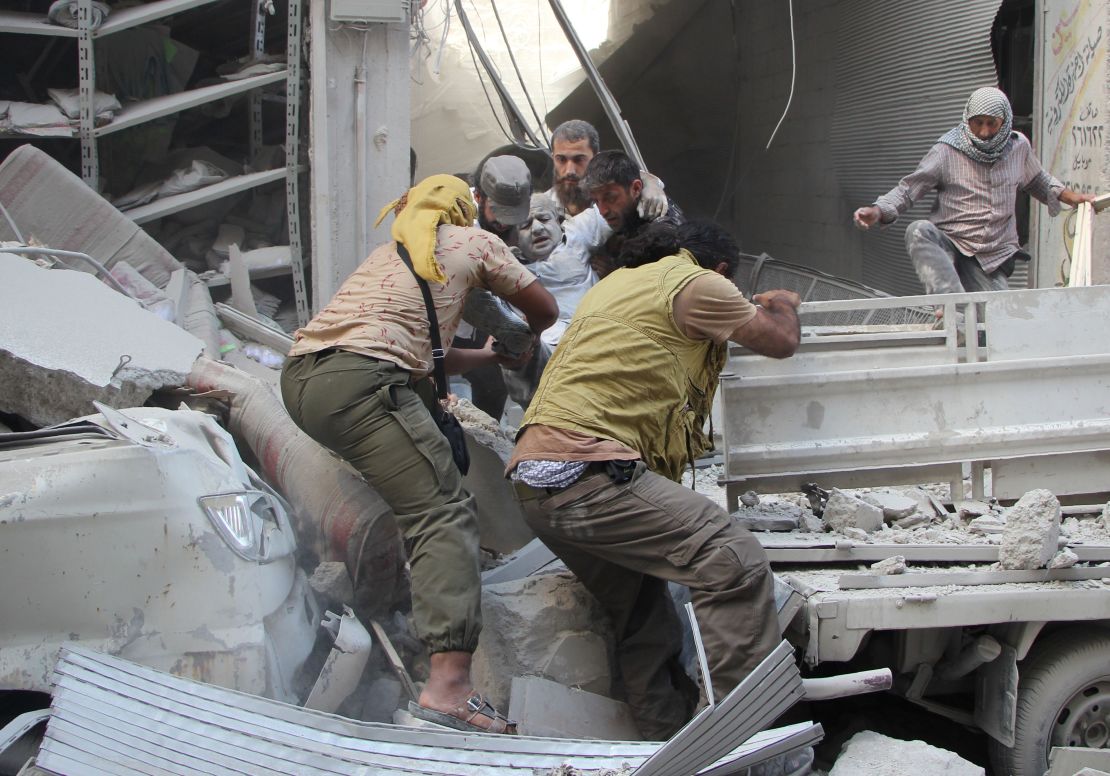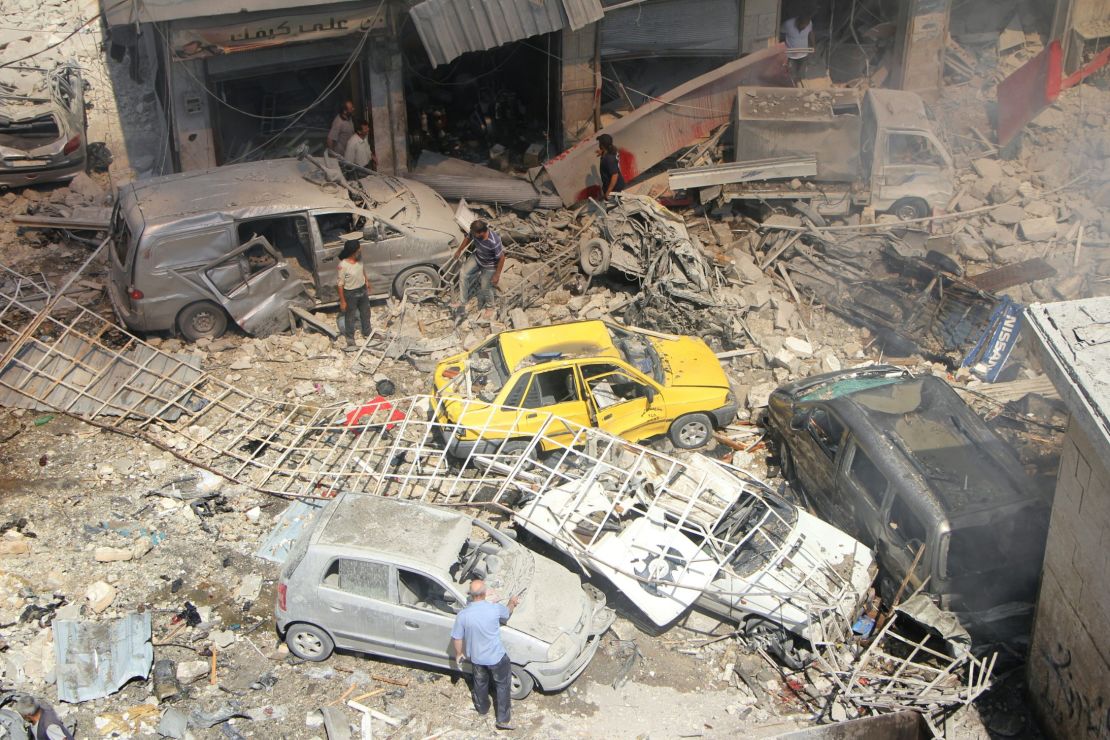Story highlights
Eyewitness: "The jets arrived over Idlib and we heard three explosions"
At least 28 children are among the dead
The US and Russia agreed to a ceasefire plan that starts Monday
At least 90 people were killed in airstrikes that rained down on northwestern Syria on Saturday and Sunday, a rights group said. The surge in violence came just hours after the US and Russia announced a new ceasefire plan.
The airstrikes landed in the rebel-held areas of Idlib in the northwest and Aleppo in the north of the country, according to the monitoring group Syrian Observatory for Human Rights.
The worst strikes were in Idlib, where at least 61 people were killed and more than 100 wounded in an attack that targeted a crowded market, an activist who witnessed the bombing and its aftermath told CNN.
The activist, who asked to be identified as Omar for security reasons, said he was in Idlib to cover the atmosphere a day ahead of the Eid al-Adha holiday. Omar took a detour to the city since the roads near the markets were closed as a security precaution, and that probably saved his life, he said.
“We heard a whistling sound then the explosions,” Omar said. The jets arrived around 12:30 p.m. local time, he said. “Two or three rockets landed in middle of the market. We left the car where we were and headed towards the site of explosion.”
Omar said Syria Civil Defense teams couldn’t reach the site quickly because of the road closures.
“We carried 30 people dead from the ground and we transferred some other 40 injured. Their injuries varied,” Omar said. “Those injured, they were clear and visible on the ground and not hidden behind cars or inside rubble. We carried them and started taking them to field hospitals. This is when the civil defense rescue teams started arriving and carrying and helping the injured as well the ones trapped under the rubble.”
Omar said the field hospitals were overwhelmed.
Video from the scene showed White Helmet rescuers – the nickname for Syria Civil Defense volunteers – carefully squeezing beneath piles of stones to look for victims. Cries of “Allahu-Akbar” filled the air when the rescuers found a victim alive and pulled them out to safety.
Peace Agreement to begin Monday
The airstrikes came just days before a ceasefire that is scheduled to go into effect at sundown Monday.
The Syrian regime announced its support of the ceasefire deal Saturday, according to the state-run TV.
US Secretary of State John Kerry said the accord, announced after hours of talks in Geneva, would prevent Syrian President Bashar al-Assad’s air force from flying combat missions anywhere the opposition is present, calling this provision the “bedrock of the agreement.” He labeled the Syrian air force the “main driver of civilian casualties” and migrant flows.
Kerry announces US-Russia deal on Syrian ceasefire
In February, a cessation of hostilities negotiated between Kerry and Russian Foreign Minister Sergey Lavrov fell apart within weeks, and efforts to reach a political settlement in the war-torn country have been on the verge of collapse.


Skepticism over deal
After five years, Syrians are weary of a war that has left more than 250,000 dead and forced nearly 5 million to flee the country. But many activists and Syrians, especially those living in rebel-held areas, remain skeptical of the latest peace deal.
“It’s in the general interest of the Syrian people to stop the rivers of blood, and stopping bloodshed is the first step,” said one Syrian in Aleppo. “It’s a good step, but what’s the guarantee that it will remain in place?”
“This is the best option of all bad options,” said Fawaz Gerges, speaking to CNN’s Becky Anderson on Sunday. Gerges is the chair of contemporary Middle East studies at the London School of Economics, and the author of “Isis: A History.”
Gerges said the big question is whether the guns that are scheduled to fall silent Monday would remain silent in the weeks and months ahead. The ceasefire deal lacks a political horizon, he said.
Gerges ticked off three points to remember in the complicated quest for peace.
1. “The reality is where do you go from there?’ he said. “The reality is the balance of power favors Assad at this particular moment.”
2. “Secondly, the Obama administration does not really want to invest any strategic capital in Syria for a variety of reasons.”
3. “The third question is, of course, the Americans and the Russians would basically have a military partnership to target ISIS and al-Qaeda and the al-Nusra Front,” Gerges said, naming just some of the terror groups operating in Syria.
“But how do you separate the various armed groups? How do you cut the umbilical cord…?” Gerges asked.
Medical centers targeted
The Syrian Network For Human Rights said at least 59 medical centers have been targeted by Russian forces since Moscow began its mission in Syria last September.
In its 17th report published this weekend, SNHR said 84% of these attacks happened in Aleppo and Idlib. The report is based on daily monitoring and documentation along with accounts by survivors, victims’ families and eyewitnesses.
“Russian forces’ attacks on medical centers and medics are a blatant violation of the international humanitarian law and amount to a war crime on account of the fact that these attacks are indiscriminate and in many cases deliberately targeted protected objects,” said Fadel Abdul Ghani, chairman of SNHR, in the report.
“These attacks have deepened the agonies of the wounded and injured and are one of the main causes of the displacement of the Syrian people as they send a very clear message: There is no safe area or a red line, including hospitals. You either flee or perish.”
CNN’s Tiffany Ap, Mohammed Tawfeek, Jennifer Hauser, Elise Labott and Ryan Browne contributed to this report.
















